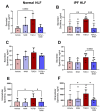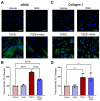Calcium-Sensing Receptor as a Novel Target for the Treatment of Idiopathic Pulmonary Fibrosis
- PMID: 40305220
- PMCID: PMC12025166
- DOI: 10.3390/biom15040509
Calcium-Sensing Receptor as a Novel Target for the Treatment of Idiopathic Pulmonary Fibrosis
Abstract
Idiopathic pulmonary fibrosis (IPF) is a disease with a poor prognosis and no curative therapies. Fibroblast activation by transforming growth factor β1 (TGFβ1) and disrupted metabolic pathways, including the arginine-polyamine pathway, play crucial roles in IPF development. Polyamines are agonists of the calcium/cation-sensing receptor (CaSR), activation of which is detrimental for asthma and pulmonary hypertension, but its role in IPF is unknown. To address this question, we evaluated polyamine abundance using metabolomic analysis of IPF patient saliva. Furthermore, we examined CaSR functional expression in human lung fibroblasts (HLFs), assessed the anti-fibrotic effects of a CaSR antagonist, NPS2143, in TGFβ1-activated normal and IPF HLFs by RNA sequencing and immunofluorescence imaging, respectively; and NPS2143 effects on polyamine synthesis in HLFs by immunoassays. Our results demonstrate that polyamine metabolites are increased in IPF patient saliva. Polyamines activate fibroblast CaSR in vitro, elevating intracellular calcium concentration. CaSR inhibition reduced TGFβ1-induced polyamine and pro-fibrotic factor expression in normal and IPF HLFs. TGFβ1 directly stimulated polyamine release by HLFs, an effect that was blocked by NPS2143. This suggests that TGFβ1 promotes CaSR activation through increased polyamine expression, driving a pro-fibrotic response. By halting some polyamine-induced pro-fibrotic changes, CaSR antagonists exhibit disease-modifying potential in IPF onset and development.
Keywords: TGFβ1; arginine–polyamine pathway; calcium/cation-sensing receptor; idiopathic pulmonary fibrosis; negative allosteric modulator.
Conflict of interest statement
Rupert Ecker is co-founder and CEO of the for-profit company TissueGnostics GmbH, which used to be a beneficiary in the EU-funded Marie–Sklodowska–Curie Innovative Training Network “CaSR Biomedicine” (Grant Agreement No 675228), which contributed to this publication. John Simpson is the lead investigator on grants with Clinigen, Aerogen, and Partner Therapeutics as co-applicants, and a co-applicant on a grant with Partner Therapeutics as a co-applicant. He has previously been an applicant on grants with Becton Dickinson as co-applicants. He is the Director of an NIHR Healthtech Research Centre that works with companies across the diagnostics industry.
Figures








Similar articles
-
Arsenic trioxide inhibits the functions of lung fibroblasts derived from patients with idiopathic pulmonary fibrosis.Toxicol Appl Pharmacol. 2022 Apr 15;441:115972. doi: 10.1016/j.taap.2022.115972. Epub 2022 Mar 9. Toxicol Appl Pharmacol. 2022. PMID: 35276128
-
A model of human lung fibrogenesis for the assessment of anti-fibrotic strategies in idiopathic pulmonary fibrosis.Sci Rep. 2018 Jan 10;8(1):342. doi: 10.1038/s41598-017-18555-9. Sci Rep. 2018. PMID: 29321510 Free PMC article.
-
Antifibrotic effects of vitamin D3 on human lung fibroblasts derived from patients with idiopathic pulmonary fibrosis.J Nutr Biochem. 2024 Mar;125:109558. doi: 10.1016/j.jnutbio.2023.109558. Epub 2024 Jan 5. J Nutr Biochem. 2024. PMID: 38185349
-
TGF‑β1: Gentlemanly orchestrator in idiopathic pulmonary fibrosis (Review).Int J Mol Med. 2021 Jul;48(1):132. doi: 10.3892/ijmm.2021.4965. Epub 2021 May 20. Int J Mol Med. 2021. PMID: 34013369 Free PMC article. Review.
-
MicroRNAs in idiopathic pulmonary fibrosis.Transl Res. 2011 Apr;157(4):191-9. doi: 10.1016/j.trsl.2011.01.012. Epub 2011 Feb 4. Transl Res. 2011. PMID: 21420029 Review.
Cited by
-
Development and characterization of AD-214, an anti-CXCR4 i-body-Fc fusion for the treatment of idiopathic pulmonary fibrosis.MAbs. 2025 Dec;17(1):2505090. doi: 10.1080/19420862.2025.2505090. Epub 2025 May 21. MAbs. 2025. PMID: 40395177 Free PMC article.
References
-
- Adegunsoye A., Oldham J.M., Bellam S.K., Montner S., Churpek M.M., Noth I., Vij R., Strek M.E., Chung J.H. Computed Tomography Honeycombing Identifies a Progressive Fibrotic Phenotype with Increased Mortality across Diverse Interstitial Lung Diseases. Ann. Am. Thorac. Soc. 2019;16:580–588. doi: 10.1513/AnnalsATS.201807-443OC. - DOI - PMC - PubMed
-
- Raghu G., Rochwerg B., Zhang Y., Garcia C.A.C., Azuma A., Behr J., Brozek J.L., Collard H.R., Cunningham W., Homma S., et al. An Official ATS/ERS/JRS/ALAT Clinical Practice Guideline: Treatment of Idiopathic Pulmonary Fibrosis. An Update of the 2011 Clinical Practice Guideline. Am. J. Respir. Crit. Care Med. 2015;192:e3–e19. doi: 10.1164/rccm.201506-1063ST. - DOI - PubMed
MeSH terms
Substances
Grants and funding
LinkOut - more resources
Full Text Sources
Miscellaneous

